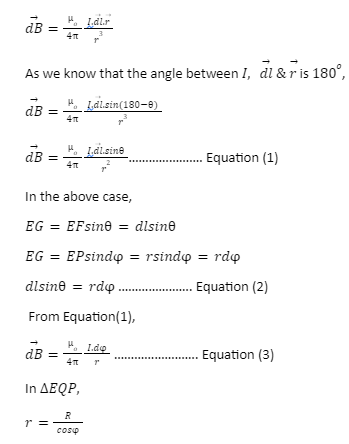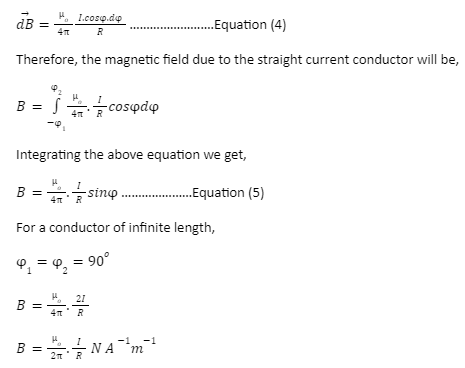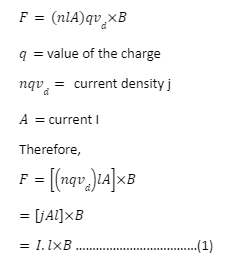Magnetic Field
A magnetic field is a vector field that describes the magnetic effect on moving electric charges, electric currents and magnetic substances. A mobile charge in a magnetic field is subjected to a force that is perpendicular to both the mobile charge’s motion and the magnetic field.
A permanent magnet’s magnetic field attracts or repels various magnets and ferromagnetic substances. A magnetic field with varying area will also exert a force on a number of non-magnetic substances by altering the movement of their outer atomic electrons. Magnetic fields surround magnetised substances, and are created by electric powered currents along with the ones utilised in electromagnets, and by electric powered fields varying in time.
Units of Magnetic Field
Tesla (T) is the SI unit for magnetic fields. It is generated from the Lorentz force law’s magnetic portion.
Fmagnetic=qvB
q= charge
v= velocity of charge
B= magnetic field
Magnetic field is symbolised by “B”.
Fleming’s Left-Hand Rule
When a current-carrying conductor is placed in a magnetic field, a force occurs on the conductor in a path that is perpendicular to both the current and the magnetic field lines.
Assume that a section of a conductor of length ‘L’ is vertically placed in a uniform horizontal magnetic field of intensity ‘B,’ created by magnetic poles N and S. If current ‘I’ is flowing through this conductor, the force experienced by the conductor is equal to:
F=BIL
Hold out your left hand with the forefinger, 2nd finger and thumb on the proper angle to one another. If the path of the magnetic field is represented by the forefinger and the path of the current is represented by the second finger, the path of the force is represented by the thumb.
When current runs through a conductor, a magnetic field is formed around it. The magnetic field can be visualised by counting the number of closed magnetic lines of force that pass through the conductor.
The path of magnetic lines of force may be decided by means of Maxwell’s corkscrew rule or right-hand grip rule. If the current is flowing away from the observer, i.e. if the route of current along the conductor is inward from the reference plane, the magnetic lines of force (or flux strains) will travel clockwise.
Now if a horizontal magnetic field is carried out externally to the conductor, those magnetic fields i.e. field across the conductor because of the current via it and the externally carried out field will have interaction with each other.
Flux
In physics, Flux is described as any impact that looks to pass or travel (whether or not it honestly moves or not) via a surface or substance. Flux may be considered as imaginary lines via which a physical amount can travel. Flux is a concept in implemented arithmetic and vector calculus with numerous physical applications. Flux is a vector quantity that describes the value and path of a property or substance’s flow during delivery.
Magnetic Flux
The number of magnetic field lines travelling through a closed surface is referred to as magnetic flux. Its SI unit is – Weber.
Magnetic force in current carrying conductor derivation
We can extend the force evaluation for a single transmitting charge to a straight rod carrying current because of the magnetic field. Consider a rod with length l and a uniform cross-sectional area A. We shall anticipate one kind of mobile carriers as in a conductor (right here electrons). Consider n to represent the numerical density of those cell charge carriers. Then there are nlA total mobile charge carriers in it. We may also expect each mobile carrier to have an average drift velocity vd for a constant current I in this conducting rod.
In the presence of an external magnetic field B, the force on these carriers will be,
Here, l is a vector of value length, that is the length of the rod, having a direction similar to current I.
Equation (1) holds for a straight rod. B is the external magnetic field in this equation. It’s not the field created with the help of a current-carrying rod. If the wire has an arbitrary shape, we shall compute the Lorentz force on it by considering it as a group of linear strips dlj and summing
The above summation may be converted to an integral in many cases.
Magnetic field due to straight current carrying conductor
Magnetic fields affect current-carrying conductors, as we all know. Any mass produces a gravitational field, which it can also interact with. Charge both generates and interacts with an electric field. We could suppose that because moving charge interacts with a magnetic field, it also creates one.
Consider a straight conductor AB carrying a current (I) and determining the magnetic field intensity at point P.
Let AB be the conductor through which current I flows. Consider a point P, placed at a certain distance from the midpoint of the conductor. Consider the small current-carrying element dl placed at point E. It is at a distance r from point p l denotes the distance between the coil’s centre and dl denotes the length. Using the Biot-Savart law, the magnetic field at point P due to current carrying element dl is

Hence,

Conclusion
All known magnetic fields are caused by current charges (or moving charges). Because charges are moving inside the conductor, a current-carrying wire produces a magnetic field. A simple experiment of maintaining a magnetic compass near any current-carrying wire can also verify this.
Current-carrying conductors come in a variety of forms and sizes. The magnetic field created by a conductor is affected by its form. It is necessary to define the theory behind these notions in order to better comprehend the nature and behaviour of the magnetic field created by these conductors.
 Profile
Profile Settings
Settings Refer your friends
Refer your friends Sign out
Sign out








